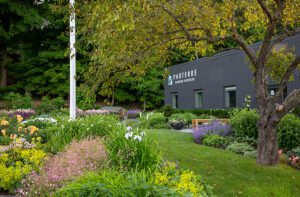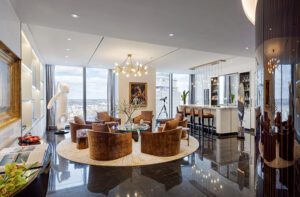European Explorers
April 6, 2016
For lovers of antiques, there’s nothing quite like a shopping trip abroad. New England designers divulge their favorite shops and markets in London and Paris.
Text by Regina Cole
The proliferation of online resources for finding antiques is a wonderful thing, but little can match the thrill of browsing a shop, fair, or antiques center. So much the better if that shop or fair is in some faraway location—in the heart of Paris, perhaps, or on the outskirts of London. For antiques lovers, crossing the pond to buy wonderful old things is the stuff of dreams. To feed those dreams, we asked New England experts to tell us about their favorite overseas haunts.
Not surprisingly, many local designers are drawn to London. For Americans embarking on their first antiquing trip to Europe, the United Kingdom is a good place to start, says Toma Clark Haines, president of The Antiques Diva & Co., a company that specializes in guided antiquing tours. The company guides visitors, mostly Americans, to antiquing destinations in France, Belgium, Italy, Germany, Holland, Sweden, Denmark, and England. “In England, dealers display wares in ways Americans will find familiar,” Clark Haines says. “Also, people want French goods, and the Brits have been plundering French antiques for hundreds of years; some of the best finds in French furniture are actually in England.”
“On King’s Road, a little shop called Opium is a great source for Indian things,” says Mally Skok. “I love to go there for antique textiles.” Portobello Market, in Notting Hill, is one of the world’s most famous street markets, and Skok enjoys visiting, especially on Saturdays, when the area takes on a carnival-like atmosphere. “I go there for the fun, not to buy,” she says. The Lincoln, Massachusetts-based textile and interior designer does, however, buy at the city’s seasonal Decorative Antiques & Textiles Fair at Battersea Park, which hosts dealers from several countries, and at the Winter Olympia Art & Antiques Fair. “At Olympia, there are big dealers, little dealers; you get a smattering of the best. At the Battersea fair, you just drool, walking around.”
Pippa Roberts, publicity and communications director for the Decorative Antiques and Textiles Fair, which runs three times a year, says, “Americans, who represent about 10 percent of our visitors, come to find European painted furniture, which is a specialty of the fair. Most of all, they come to search out the quirky and the unusual, for which the fair is renowned.”
Gregory Van Boven, whose interior design firm is located on Boston’s Marlborough Street, has a growing list of favorites spots. “Mallett at Ely House on Dover Street has four floors of fine pieces from the eighteenth-century and Regency periods,” he says. “I always go to Sibyl Colefax & John Fowler Antiques for good pieces from the eighteenth century to modern.”
Van Boven lists Reindeer Antiques Ltd. on Kensington Church Street, a specialist in Georgian antique furniture, the London Silver Vaults on Chancery Lane for silver from the sixteenth century to modern, and Soane Antiques on Pimlico Road for eclectic pieces of furniture, art, and accessories. And then there is Colin Smith and Gerald Robinson Antiques, he adds. “They deal by appointment only, and have amazing and wonderful objects of silver, tortoiseshell, and shagreen.”
Cambridge, Massachusetts, interior designer Susan Reddick has her own list of favorites. “Many are in the Pimlico Road area, a center of antiques shopping at all levels from flea markets to fine antiques,” she says. “Hilary Batstone has a charming shop in Holbein Place. Her selections are light, airy, sophisticated, often with a Swedish or Continental touch. Jamb, which is also represented by Michael Smith’s Los Angeles shop, Jasper, has a wonderful reputation as a resource for antique and reproduction fireplace mantels. Moving into Bloomsbury, another favorite resource is Pentreath & Hall, with an eclectic mixture of furnishings, accessories, and artwork.”
Shoppers will find that prices are lower outside the big cities, Clark Haines says. Just outside of Tetbury in the Cotswolds, a couple of hours west of London, Lorfords is a new and rapidly growing multi-dealer destination located at an old airfield; two vast aircraft hangers house more than forty dealers.
Beacon Hill antiques dealer François Bardonnet says, “I started loving antiques when I grew up in Paris. Today, I still go to some of the same shops I visited with my parents.”
He finds Paris more affordable than London. “Things are very expensive in London because of the exchange rate,” he says, “though I do go to dealers in Kensington Church Street for porcelain, china, and ceramics.”
In Paris, Bardonnet says, “The ‘money is no object’ dealers are Didier Aaron for Old Master drawings and paintings as well as decorative arts. Kugel, which helped Yves Saint Laurent build his collection, is known for extraordinary eighteenth-century French antiques, including some with royal provenance. And Steinitz has the most extraordinary collection of period paneling.” Didier Aaron also has a gallery in London, and, for those who prefer to stay closer to home, one in New York City.
At the more affordable end, Bardonnet likes Galerie JM Béalu & Fils for porcelain and ceramics, Galerie Jean-Pierre Gros for its large chandeliers. “Philippe Vichot has a great eye and wonderful things, and for eclectic things, I go to Galerie Sylvain Lévy-Alban,” he adds.
Clark Haines extols the benefits of shopping with a local guide. “When you walk into the Marché aux Puces, the Paris Flea Market, as a foreigner, you get foreigner prices,” she says. “But the vendors know us: they see us bring customers every weekend. We can get better prices. Also, they are more apt to tell the truth when we are there.”
She points out the hidden cost of shopping abroad. “If you buy only one thing, it’s bloody expensive, because it will cost as much to ship as to buy. If you ship a number of objects together, it’s a much better deal.”
Pippa Roberts agrees that buying more can yield bigger savings. “Many U.S. trade buyers find it easier to shop at the Decorative Fair, as they find a huge variety under one roof; it is often cheaper to shop in one go here and do one large shipment out of a single venue, rather than traversing different European antiques hubs and shipping piecemeal.”
The Continent’s best deals, says Clark Haines, are at the half-day wholesale fairs, known as déballages, in the south of France. “They happen about six times a year, are open only to the trade, and are intense, crazy events,” she says. “There is just a four-hour window, so it’s all about fast decisions. We bring designers, architects, and antiques dealers, who are overwhelmed at first. Then they get addicted.” •
Share
![NEH-Logo_Black[1] NEH-Logo_Black[1]](https://b2915716.smushcdn.com/2915716/wp-content/uploads/2022/08/NEH-Logo_Black1-300x162.jpg?lossy=1&strip=1&webp=1)




















You must be logged in to post a comment.